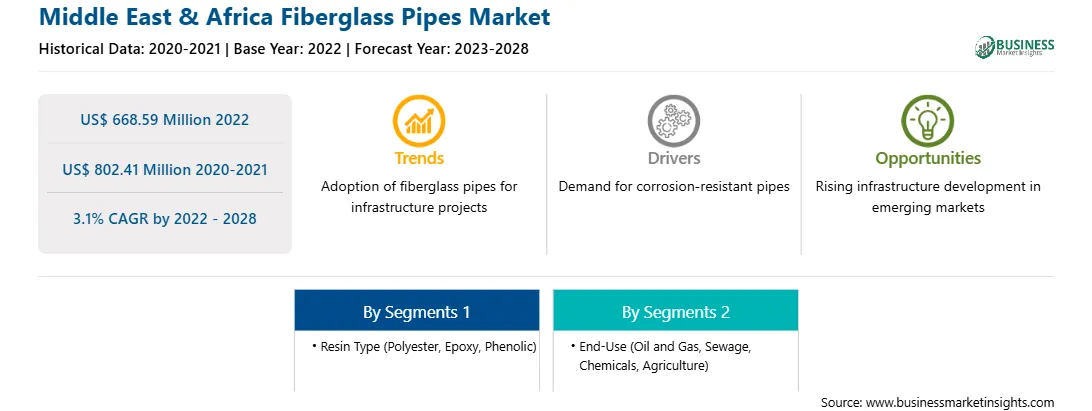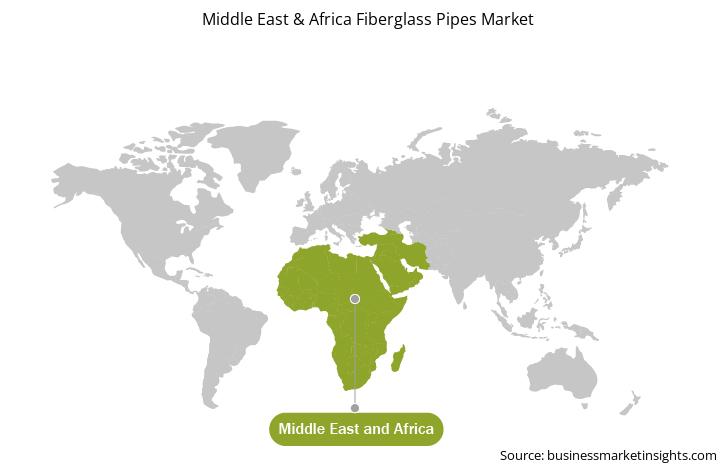Pipes manufactured from metal, concrete, and plastics are widely used for wastewater and sewage applications. However, municipalities and governments are facing concerns pertaining to service life of pipelines and replacement of aging infrastructure with the right materials with long service life and low maintenance. The ease of installation, lightweight, long service life, corrosion resistance, and low electrical conductivity are a few characteristics of fiberglass pipes that positively influence its utilization in wastewater applications over other types of pipes. In the wastewater industry, fiberglass pipes are used in chemical water treatment, industrial wastewater treatment, gravity sewer systems, and demineralization.
Government initiatives pertaining to developing wastewater and sewage infrastructure in several countries are promoting the expansion or construction of pipelines.
The Middle East & Africa (MEA) fiberglass pipes market is segmented into South Africa, Saudi Arabia, the UAE, and the Rest of MEA. The market growth is attributed to the high demand for fiberglass pipes from industries such as oil & gas, water treatment, and chemical. The Middle East & Africa has abundant resources, including oil and gas and other natural resources. According to the US Energy Information Administration, the Middle East includes five of the top ten oil-producing countries, including Saudi Arabia, Iraq, the UAE, Iran, and Kuwait. It is responsible for producing ~27% of total oil production across the globe. Further, developing and developed countries in the region are encouraging international trade of their oil and gas products. For instance, in March 2023, the government of Uganda approved an application to build an 898-mile (1,445 km) pipeline designed to transport the country's crude oil to international markets. An investment of US$ 3.5 billion was made on this project, which was planned by Total Energies. The project’s aim is to construct the pipeline from Uganda's oilfields in the west to a port on Tanzania's Indian Ocean coast. Thus, the strong presence of the oil & gas sector in the region creates a huge demand for fiberglass pipes.
Further, fiberglass pipes are widely used in the mining industry, where highly resilient materials are required to withstand harsh environmental conditions, as well as corrosive chemicals in the metal processing plants. Fiberglass pipes are widely used for the ore reduction process. The growth of the mining and oil & gas industry provides lucrative opportunities for the fiberglass pipes market growth in the region.
The Middle East & Africa fiberglass pipes market is segmented into resin type, end use, and country.
Based on resin type, the Middle East & Africa fiberglass pipes market is segmented into polyester, epoxy, phenolic, and others. The polyester segment held a largest Middle East & Africa fiberglass pipes market share in 2022.
Based on end use, the Middle East & Africa fiberglass pipes market is segmented into oil and gas, sewage, chemicals, agriculture, and others. The oil and gas segment held the largest Middle East & Africa fiberglass pipes market share in 2022.
Based on country, the Middle East & Africa fiberglass pipes market has been categorized into South Africa, Saudi Arabia, the UAE, and the Rest of Middle East & Africa. Saudi Arabia dominated the Middle East & Africa fiberglass pipes market share in 2022.
Amiblu Holding GmbH, Chemical Process Piping Pvt Ltd, EPP Composites Pvt Ltd, Fibrex FRP Piping Systems, Future Pipe Industries LLC, Gruppo Sarplast Srl, Kuzeyboru AS, NOV Inc, Saudi Arabian Amiantit Co, Sunrise Industries (India) Ltd, Poly Plast Chemi Plants (I) Pvt Ltd, and Plasticon Germany GmbH are the leading companies operating in the Middle East & Africa fiberglass pipes market.
Strategic insights for the Middle East & Africa Fiberglass Pipes provides data-driven analysis of the industry landscape, including current trends, key players, and regional nuances. These insights offer actionable recommendations, enabling readers to differentiate themselves from competitors by identifying untapped segments or developing unique value propositions. Leveraging data analytics, these insights help industry players anticipate the market shifts, whether investors, manufacturers, or other stakeholders. A future-oriented perspective is essential, helping stakeholders anticipate market shifts and position themselves for long-term success in this dynamic region. Ultimately, effective strategic insights empower readers to make informed decisions that drive profitability and achieve their business objectives within the market.

| Report Attribute | Details |
|---|---|
| Market size in 2022 | US$ 668.59 Million |
| Market Size by 2028 | US$ 802.41 Million |
| Global CAGR (2022 - 2028) | 3.1% |
| Historical Data | 2020-2021 |
| Forecast period | 2023-2028 |
| Segments Covered |
By Resin Type
|
| Regions and Countries Covered | Middle East and Africa
|
| Market leaders and key company profiles |
The geographic scope of the Middle East & Africa Fiberglass Pipes refers to the specific areas in which a business operates and competes. Understanding local distinctions, such as diverse consumer preferences (e.g., demand for specific plug types or battery backup durations), varying economic conditions, and regulatory environments, is crucial for tailoring strategies to specific markets. Businesses can expand their reach by identifying underserved areas or adapting their offerings to meet local demands. A clear market focus allows for more effective resource allocation, targeted marketing campaigns, and better positioning against local competitors, ultimately driving growth in those targeted areas.

The Middle East & Africa Fiberglass Pipes Market is valued at US$ 668.59 Million in 2022, it is projected to reach US$ 802.41 Million by 2028.
As per our report Middle East & Africa Fiberglass Pipes Market, the market size is valued at US$ 668.59 Million in 2022, projecting it to reach US$ 802.41 Million by 2028. This translates to a CAGR of approximately 3.1% during the forecast period.
The Middle East & Africa Fiberglass Pipes Market report typically cover these key segments-
The historic period, base year, and forecast period can vary slightly depending on the specific market research report. However, for the Middle East & Africa Fiberglass Pipes Market report:
The Middle East & Africa Fiberglass Pipes Market is populated by several key players, each contributing to its growth and innovation. Some of the major players include:
The Middle East & Africa Fiberglass Pipes Market report is valuable for diverse stakeholders, including:
Essentially, anyone involved in or considering involvement in the Middle East & Africa Fiberglass Pipes Market value chain can benefit from the information contained in a comprehensive market report.